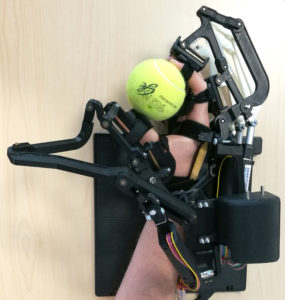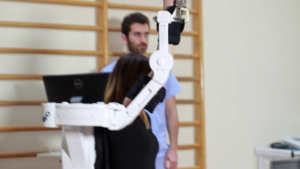At the Human-Robot Interaction area there is a long tradition of research in the area of exoskeletons and wearable robots.
You will find here some updated information on hand exoskeletons and upper limb exoskeletons.

Hand Exoskeletons
At HRI we are studying and developing novel hand exoskeleton for hand rehabilitation.
Exoskeletons can be used for robotic assisted rehabilitation in stroke and for telepresence applications.
Our patented hand exoskeleton is based on an innovative kinematics that can self-adapt to hand kinematics, and transmit forces only normal to finger phalanges.
We devised novel rendering strategies for force mapping in underactuated devices.
Reference publications:
- Sarac, M., Solazzi, M., & Frisoli, A. (2019). Design Requirements of Generic Hand Exoskeletons and Survey of Hand Exoskeletons for Rehabilitation, Assistive, or Haptic Use. IEEE transactions on haptics, 12(4), 400-413 [pdf].
- Sarac, M., Solazzi, M., Sotgiu, E., Bergamasco, M., & Frisoli, A. (2017). Design and kinematic optimization of a novel underactuated robotic hand exoskeleton. Meccanica, 52(3), 749-761. [pdf]
- Sarac, M., Solazzi, M., Leonardis, D., Sotgiu, E., Bergamasco, M., & Frisoli, A. (2017). Design of an underactuated hand exoskeleton with joint estimation. In Advances in Italian Mechanism Science (pp. 97-105). Springer, Cham.[pdf]
- Sarac, M., Solazzi, M., Otaduy, M. A., & Frisoli, A. (2018). Rendering strategies for underactuated hand exoskeletons. IEEE Robotics and Automation Letters, 3(3), 2087-2092. [pdf]
- Lobo, D., Saraç, M., Verschoor, M., Solazzi, M., Frisoli, A., & Otaduy, M. A. (2017, June). Proxy-based haptic rendering for underactuated haptic devices. In 2017 IEEE World Haptics Conference (WHC) (pp. 48-53). IEEE. Best Paper Award [pdf]

Upper limb exoskeleton and robotic assisted neurorehabilitaiton
The ALEx exoskeleton is now commercialized by Wearable Robotics srl, and it is an innovative.
We conducted since 2007 clinical studies on the efficacy of exoskeleton for neurological rehabilitation in stroke.
Our robot solutions rely on tendon based solutions that allow to achieve very transparent and high bandwidth devices.
Reference Publications:
- Pirondini, E., Coscia, M., Marcheschi, S., Roas, G., Salsedo, F., Frisoli, A., … & Micera, S. (2016). Evaluation of the effects of the Arm Light Exoskeleton on movement execution and muscle activities: a pilot study on healthy subjects. Journal of neuroengineering and rehabilitation, 13(1), 9
- Frisoli, A., Rocchi, F., Marcheschi, S., Dettori, A., Salsedo, F., & Bergamasco, M. (2005, March). A new force-feedback arm exoskeleton for haptic interaction in virtual environments. In First Joint Eurohaptics Conference and Symposium on Haptic Interfaces for Virtual Environment and Teleoperator Systems. World Haptics Conference (pp. 195-201). IEEE.
- Frisoli, A., Salsedo, F., Bergamasco, M., Rossi, B., & Carboncini, M. C. (2009). A force-feedback exoskeleton for upper-limb rehabilitation in virtual reality. Applied Bionics and Biomechanics, 6(2), 115-126.
- Frisoli, Antonio, et al. “A new gaze-BCI-driven control of an upper limb exoskeleton for rehabilitation in real-world tasks.” IEEE Transactions on Systems, Man, and Cybernetics, Part C (Applications and Reviews) 42.6 (2012): 1169-1179.
- Frisoli, A., Procopio, C., Chisari, C., Creatini, I., Bonfiglio, L., Bergamasco, M., … & Carboncini, M. C. (2012). Positive effects of robotic exoskeleton training of upper limb reaching movements after stroke. Journal of neuroengineering and rehabilitation, 9(1), 36.



